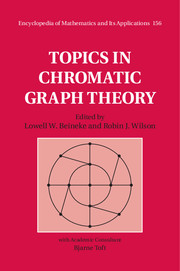Book contents
- Frontmatter
- Contents
- Foreword
- Preface
- Preliminaries
- 1 Colouring graphs on surfaces
- 2 Brooks's theorem
- 3 Chromatic polynomials
- 4 Hadwiger's conjecture
- 5 Edge-colourings
- 6 List-colourings
- 7 Perfect graphs
- 8 Geometric graphs
- 9 Integer flows and orientations
- 10 Colouring random graphs
- 11 Hypergraph colouring
- 12 Chromatic scheduling
- 13 Graph colouring algorithms
- 14 Colouring games
- 15 Unsolved graph colouring problems
- Notes on contributors
- Index
- References
12 - Chromatic scheduling
Published online by Cambridge University Press: 05 May 2015
- Frontmatter
- Contents
- Foreword
- Preface
- Preliminaries
- 1 Colouring graphs on surfaces
- 2 Brooks's theorem
- 3 Chromatic polynomials
- 4 Hadwiger's conjecture
- 5 Edge-colourings
- 6 List-colourings
- 7 Perfect graphs
- 8 Geometric graphs
- 9 Integer flows and orientations
- 10 Colouring random graphs
- 11 Hypergraph colouring
- 12 Chromatic scheduling
- 13 Graph colouring algorithms
- 14 Colouring games
- 15 Unsolved graph colouring problems
- Notes on contributors
- Index
- References
Summary
Variations and extensions of the basic vertex-colouring and edge-colouring models have been developed to deal with increasingly complex scheduling problems. We present and illustrate them in specific situations where additional requirements are imposed. We include list-colouring, mixed graph colouring, co-colouring, colouring with preferences and bandwidth colouring, and we present applications of edge-colourings to open shop, school timetabling and sports scheduling problems. We also discuss balancing and compactness constraints which often appear in practical situations.
Introduction
We show here how graph colouring models may provide a natural tool for dealing with a variety of scheduling problems. Starting from the basic vertex-colouring model, we will introduce some variations and extensions that are motivated by their applications to some scheduling issues. In each case we give references for further results and for extensions of the various models presented. For algorithms, see Chapter 13.
In chromatic scheduling problems we have a collection V of items, such as operations of jobs to be performed. In V there are some pairs v, w that are subject to an incompatibility condition and we call E the set of such incompatibility pairs. These data are represented by the graph G = (V, E) in which the items are associated with the vertices and the incompatible pairs v,w with the edges vw between the corresponding vertices.
We also have a set C = {1, 2, …, k} of time periods (of unit duration). Assuming that each item (considered as an operation) has unit completion time, we may ask whether we can find a schedule taking the incompatibilities into account and using at most k periods of time. This is precisely the vertex k-colouring problem: there exists a feasible schedule if and only if the set V of vertices can be partitioned into subsets S1, S2, …, Sk, where each Si contains no two incompatible items.
In some instances, we may try to find the smallest set C of periods (that is, the smallest k) for which a schedule in time k = |C| exists.
- Type
- Chapter
- Information
- Topics in Chromatic Graph Theory , pp. 255 - 276Publisher: Cambridge University PressPrint publication year: 2015
References
- 1
- Cited by



